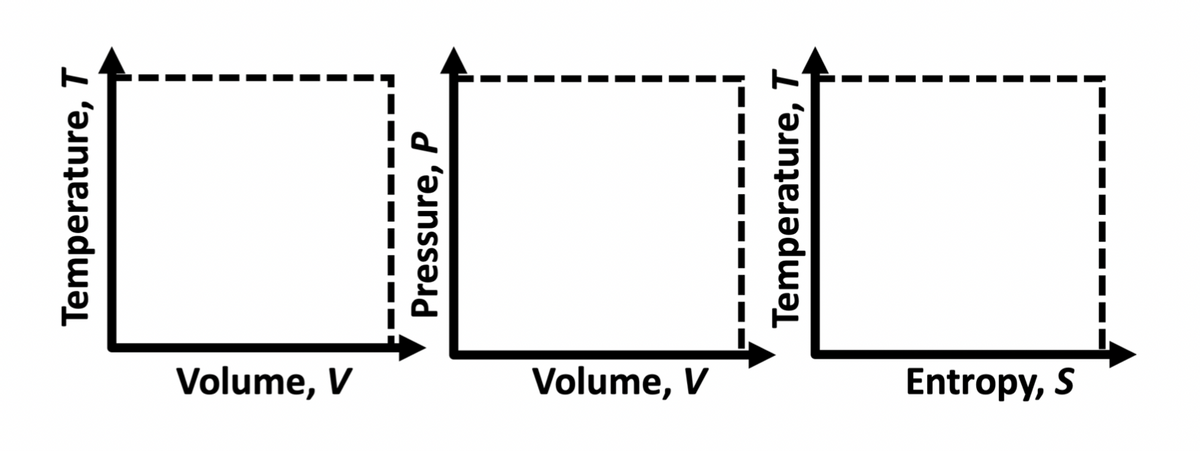The Stirling engine (invented in 1816 by Robert Stirling) is a heat engine that produces work through cyclic compression and expansion of a gaseous working fluid, such as hot air. An idealized cyclic process, aptly named the Stirling Cycle, for such an engine consists of four steps: (A) isothermal expansion at the hot reservoir temperature, Th, (B) isochoric (constant volume) heat rejection to a regenerative heat exchanger, (C) isothermal compression at the cold reservioir temperature Tc, and (D) isochoric heat absorption from the regenerative heat exchanger back to the initial state.
The Stirling engine (invented in 1816 by Robert Stirling) is a heat engine that produces work through cyclic compression and expansion of a gaseous working fluid, such as hot air. An idealized cyclic process, aptly named the Stirling Cycle, for such an engine consists of four steps: (A) isothermal expansion at the hot reservoir temperature, Th, (B) isochoric (constant volume) heat rejection to a regenerative heat exchanger, (C) isothermal compression at the cold reservioir temperature Tc, and (D) isochoric heat absorption from the regenerative heat exchanger back to the initial state.
Elements Of Electromagnetics
7th Edition
ISBN:9780190698614
Author:Sadiku, Matthew N. O.
Publisher:Sadiku, Matthew N. O.
ChapterMA: Math Assessment
Section: Chapter Questions
Problem 1.1MA
Related questions
Question
Qualitatively sketch and annotate the Stirling cycle on the following thermodynamic
diagrams. Be sure to indicate where the various steps (A, B, C, D) are taking place on the diagram.

Transcribed Image Text:Temperature, T
Volume, V
Pressure, P
Volume, V
Temperature, T
Entropy, S

Transcribed Image Text:The Stirling engine (invented in 1816 by Robert Stirling) is a heat engine that produces work
through cyclic compression and expansion of a gaseous working fluid, such as hot air. An idealized
cyclic process, aptly named the Stirling Cycle, for such an engine consists of four steps:
(A) isothermal expansion at the hot reservoir temperature, Th,
(B) isochoric (constant volume) heat rejection to a regenerative heat exchanger,
(C) isothermal compression at the cold reservioir temperature Tc, and
(D) isochoric heat absorption from the regenerative heat exchanger back to the initial state.
Expert Solution
This question has been solved!
Explore an expertly crafted, step-by-step solution for a thorough understanding of key concepts.
Step by step
Solved in 2 steps with 1 images

Knowledge Booster
Learn more about
Need a deep-dive on the concept behind this application? Look no further. Learn more about this topic, mechanical-engineering and related others by exploring similar questions and additional content below.Recommended textbooks for you

Elements Of Electromagnetics
Mechanical Engineering
ISBN:
9780190698614
Author:
Sadiku, Matthew N. O.
Publisher:
Oxford University Press

Mechanics of Materials (10th Edition)
Mechanical Engineering
ISBN:
9780134319650
Author:
Russell C. Hibbeler
Publisher:
PEARSON

Thermodynamics: An Engineering Approach
Mechanical Engineering
ISBN:
9781259822674
Author:
Yunus A. Cengel Dr., Michael A. Boles
Publisher:
McGraw-Hill Education

Elements Of Electromagnetics
Mechanical Engineering
ISBN:
9780190698614
Author:
Sadiku, Matthew N. O.
Publisher:
Oxford University Press

Mechanics of Materials (10th Edition)
Mechanical Engineering
ISBN:
9780134319650
Author:
Russell C. Hibbeler
Publisher:
PEARSON

Thermodynamics: An Engineering Approach
Mechanical Engineering
ISBN:
9781259822674
Author:
Yunus A. Cengel Dr., Michael A. Boles
Publisher:
McGraw-Hill Education

Control Systems Engineering
Mechanical Engineering
ISBN:
9781118170519
Author:
Norman S. Nise
Publisher:
WILEY

Mechanics of Materials (MindTap Course List)
Mechanical Engineering
ISBN:
9781337093347
Author:
Barry J. Goodno, James M. Gere
Publisher:
Cengage Learning

Engineering Mechanics: Statics
Mechanical Engineering
ISBN:
9781118807330
Author:
James L. Meriam, L. G. Kraige, J. N. Bolton
Publisher:
WILEY